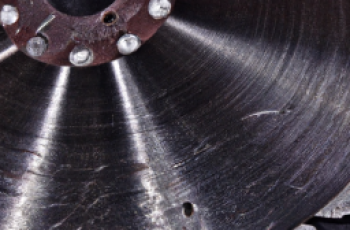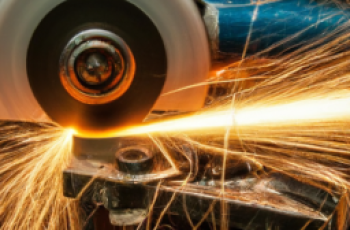You may have heard of a bench grinder before, but do you know how to use one? In this article, we will explore the basics of bench grinder operation, providing you with the essential knowledge to get started. Whether you are a novice or an experienced user, understanding the fundamentals of using a bench grinder is crucial for achieving optimal results and ensuring safety. From learning about the different parts of a bench grinder to understanding the various grinding wheel types, this article will equip you with the knowledge to confidently and effectively operate a bench grinder. Let’s dive in!

Understanding the Bench Grinder
A bench grinder is a power tool that consists of a motor and two grinding wheels mounted on a spindle. It is commonly used for shaping, sharpening, and polishing metal objects. The grinding wheels rotate at high speeds, allowing you to remove material from the workpiece quickly and efficiently. Bench grinders come in different sizes and styles, but they all operate in a similar manner.
Types of Bench Grinders
There are two main types of bench grinders: the standard bench grinder and the pedestal grinder. The standard bench grinder is small and compact, making it a popular choice for home workshops or small-scale projects. It is designed to be mounted on a workbench and has a single motor that powers both grinding wheels.
On the other hand, a pedestal grinder is larger and more powerful. It is typically used in industrial settings or large workshops where heavy-duty grinding tasks are performed. The pedestal grinder has separate motors for each grinding wheel and is mounted on a pedestal or a stand.
Key Components of a Bench Grinder
To better understand how a bench grinder operates, it’s important to know its key components. The main components of a bench grinder include:
-
Motor: The motor is the heart of the bench grinder. It provides the power needed to rotate the grinding wheels at high speeds. The motor’s power rating determines the grinder’s overall performance and capabilities.
-
Grinding Wheels: The grinding wheels are the most essential part of a bench grinder. They come in different shapes and sizes, each designed for specific grinding tasks. The grinding wheels are made from abrasive materials such as aluminum oxide or silicon carbide and are essential for removing material from the workpiece.
-
Tool Rests: The tool rests are adjustable supports located on either side of the grinding wheels. They are used to hold the workpiece in place and provide stability and control during the grinding process. Tool rests are crucial for achieving accurate and precise grinding results.
-
Eye Shields: Eye shields are protective covers that are positioned in front of each grinding wheel. They are designed to protect your eyes from sparks, debris, and flying fragments that may be produced during the grinding process. Eye shields should always be used to ensure safety while operating a bench grinder.
Understanding Safety Precautions
Safety should always be a top priority when operating a bench grinder. Here are some important safety precautions to keep in mind:
-
Eye Protection: Always wear safety goggles or a face shield to protect your eyes from sparks and debris.
-
Face Shield: Use a face shield in addition to safety goggles for added protection against larger fragments or sparks.
-
Dust Mask: If you are working in a dusty environment, wear a dust mask to prevent inhalation of harmful particles.
-
Protective Clothing: Wear long sleeves, pants, and closed-toe shoes to protect your skin from sparks and to prevent loose clothing from getting caught in the grinder.
-
Proper Lighting: Ensure that your work area is well-lit to see the workpiece and grinding wheel clearly.
-
Secure Work Area: Always operate the bench grinder in a secure and stable work area free from clutter or hazards.
-
Keep Hands Clear: Never touch the grinding wheel while it is in motion, and keep your hands a safe distance away from the rotating wheels.
-
Cooling Periods: Allow the bench grinder to cool down before touching or performing any maintenance tasks on it.
By following these safety precautions, you can avoid accidents and ensure a safe and productive grinding experience.

Choosing the Right Grinding Wheel
Selecting the right grinding wheel is crucial for achieving accurate and efficient grinding results. Here are some factors to consider when choosing a grinding wheel for your bench grinder:
-
Material: Consider the material you are going to work on. Different materials require different types of grinding wheels. For example, aluminum oxide wheels are suitable for general-purpose grinding, while silicon carbide wheels are better for grinding non-ferrous metals.
-
Grit Size: The grit size refers to the coarseness or fineness of the abrasive particles on the grinding wheel. Coarser grits are suitable for rough grinding or material removal, while finer grits are used for finer finishing or polishing.
-
Wheel Diameter: Wheel diameter determines the depth and width of the grinding cut. Choose a wheel diameter that best suits your grinding needs.
-
Wheel Hardness: Wheel hardness affects the rate of material removal and the heat generated during grinding. Softer wheels are better for grinding hard materials, while harder wheels are more suitable for grinding softer materials.
-
Speed Rating: Check the speed rating of the grinding wheel to ensure that it matches the maximum speed of your bench grinder. Using a wheel with a higher speed rating can be dangerous and may cause the wheel to break.
By considering these factors and selecting the appropriate grinding wheel, you can ensure optimal performance and achieve the desired grinding results.
Setting up the Bench Grinder
Before you begin using a bench grinder, it’s essential to set it up properly. Here are the steps to follow:
-
Choose the Location: Find a suitable location for your bench grinder. Ideally, it should be placed on a sturdy workbench with enough space for you to comfortably operate the grinder and maneuver the workpiece.
-
Secure the Grinder: Ensure that the bench grinder is securely mounted or bolted down to prevent vibrations or movement during operation. This will provide stability and improve the accuracy of your grinding results.
-
Adjust the Tool Rests: Position the tool rests at the appropriate distance from the grinding wheels. They should be close enough to support the workpiece but far enough to allow easy maneuverability.
-
Install Eye Shields: Attach the eye shields in front of each grinding wheel and adjust them to provide adequate protection for your eyes.
-
Check Power Supply: Connect the bench grinder to a suitable power supply and ensure that the power cord is in good condition.

Powering On the Bench Grinder
With the bench grinder set up and ready, it’s time to power it on and start grinding. Here’s how you can safely power on your bench grinder:
-
Check for Clearance: Make sure there are no obstructions near the grinding wheels and that your work area is clear of any potential hazards.
-
Stand Clear: Stand to the side of the bench grinder, away from the rotating wheels, before turning it on.
-
Power On: Turn on the bench grinder by pressing the power switch or flipping the power switch.
-
Observe: Allow the grinding wheels to reach full speed before beginning your grinding tasks. Observe the wheels for any wobbling or vibrations, which may indicate an unbalanced wheel.
-
Proceed with Caution: When starting to grind, ease the workpiece onto the grinding wheel gradually. Apply steady pressure and maintain proper control of the workpiece throughout the process.
Always remember to be cautious while operating the bench grinder and to maintain proper control and stability during the grinding process.
Grinding Techniques and Tips
To achieve the best grinding results, it’s important to use proper techniques and follow these tips:
-
Even Pressure: Apply even pressure to the workpiece while grinding to ensure consistent results. Avoid pressing too hard, as it can lead to heat buildup and reduce grinding efficiency.
-
Cool Down: Frequently dip the workpiece in water or use a coolant to prevent overheating and to extend the life of the grinding wheel.
-
Angle of Approach: Maintain a consistent angle of approach between the workpiece and the grinding wheel to achieve uniform grinding and avoid uneven surfaces.
-
Reposition the Workpiece: Frequently reposition the workpiece to prevent excessive material removal in one area and to ensure an even grind.
-
Work in Passes: If you have a large workpiece, grind it in several passes to prevent excessive heat buildup and to achieve a more accurate grind.
Following these techniques and tips will help you achieve precise grinding results and enhance the overall efficiency of your bench grinder.
Proper Dressing of the Grinding Wheel
To ensure optimal performance and prolong the life of your grinding wheel, regular dressing is necessary. Dressing a grinding wheel involves removing any embedded debris, reshaping the wheel, and exposing sharp grains. Here’s how you can properly dress your grinding wheel:
-
Power Off: Turn off the bench grinder and unplug it from the power supply before starting the dressing process.
-
Use a Dressing Tool: Choose a suitable dressing tool, such as a dressing stick or a diamond dresser, depending on the type of grinding wheel and the required dressing method.
-
Apply Light Pressure: Hold the dressing tool against the rotating grinding wheel with light pressure. Ensure that the tool is positioned correctly, avoiding any contact with the tool rests or other parts of the bench grinder.
-
Move the Tool: Move the dressing tool back and forth across the grinding wheel, maintaining a consistent pressure. This will remove any embedded debris and expose fresh abrasive grains.
-
Check the Result: Stop dressing periodically to inspect the wheel’s surface. Ensure that it is even, clean, and free from any irregularities or clogged grains.
Properly dressing the grinding wheel will improve its cutting performance, reduce heat generation, and extend its lifespan, ultimately enhancing the effectiveness of your bench grinder.
Cleaning and Maintenance of the Bench Grinder
Regular cleaning and maintenance are essential for keeping your bench grinder in optimal condition. Here are some steps to follow:
-
Power Off: Always turn off the bench grinder and unplug it from the power supply before performing any cleaning or maintenance tasks.
-
Wipe Down: Use a clean, dry cloth to wipe down the grinding wheels and the surfaces of the bench grinder. Remove any dust, debris, or excess coolant from the grinder.
-
Lubrication: Apply a small amount of lubricating oil to the moving parts and the motor shaft to ensure smooth operation and prevent rusting.
-
Inspect the Power Cord: Periodically check the power cord for any signs of damage, such as fraying or exposed wires. If any damage is found, replace the cord immediately.
-
Replace Grinding Wheels: Regularly inspect the grinding wheels for signs of wear or damage. If the grinding wheels are worn out or cracked, replace them with new ones to maintain optimal performance.
By following these simple cleaning and maintenance practices, you can prolong the lifespan of your bench grinder and ensure consistent and efficient grinding results.
In conclusion, understanding the operation of a bench grinder is key to utilizing this versatile tool effectively. From understanding its components and safety precautions to choosing the right grinding wheel and properly maintaining the grinder, you can maximize its performance and achieve precise grinding results. By mastering the techniques and tips discussed, you’ll be well on your way to becoming a skilled bench grinder operator. Remember, always prioritize safety and take the time to properly set up and maintain your bench grinder for a productive and enjoyable grinding experience.



